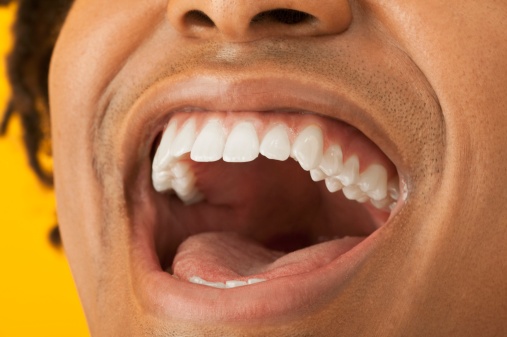When I was little I had 20 'baby' teeth.
When I was six, new teeth pushed the 'baby' ones out.
Most people get 32 second teeth.
Sharp teeth cut and bite food.
Flat, back teeth crush food.
Brushing and flossing keeps teeth clean.
First or 'Baby' teeth
'Baby’ teeth are pushed out and are replaced by permanent teeth. © Getty Images
At between six and ten months of age, most babies start to get their first teeth known as 'baby' teeth and by three years of age most children have all of their 'baby' teeth. 'Baby' teeth hold the place for the permanent teeth which will grow later. 'Baby' teeth help young children to speak and chew.
Permanent teeth
At about seven years of age, the 'baby' teeth start to fall out. Permanent teeth grow in their place. Most people have all of their permanent teeth by the time they are 21. Most people have 32 permanent teeth.
Different teeth for different jobs
Teeth have a different shape for different jobs. Getty Images
Incisors
Incisors are the teeth in the very front. They are the sharpest teeth. They cut food and are shaped to carry food inward.
Canines
Canine teeth are in the corners of the mouth. They are used to grab and tear food.
Premolars
© Getty Images
Premolars are behind the canine teeth. Premolars have a flat surface and are used to crush food.
Molars
Molars are the teeth right at the back of the mouth. Molars are big and flat and are used to chew and grind food into small pieces.
Teeth are made of layers of 4 kinds of tissue: enamel, dentine, pulp, cementum © Getty Images
What are teeth made of?
Four different kinds of tissue make up each tooth:
Enamel is the hard, white covering. Enamel protects the tooth from the wear and tear of chewing. The enamel on your teeth is the hardest substance in your body.
Dentine is below the enamel on your teeth. It's a yellow bone-like material that's softer than enamel and carries some of the nerves that tell you when something is going wrong inside your tooth.
Pulp is the centre of the tooth. It's a soft tissue that contains blood vessels and nerves. The pulp is how the tooth receives nourishment and sends signals to your brain.
Cementum is what covers most of the root of the tooth. It helps to attach the tooth to the bones in your jaw.
A cushioning layer called the Periodontal Ligament sits between the cementum and the jawbone. It helps to connect the two.
Eating for healthy teeth
Fruits, vegetables, nuts, cheese and milk are foods for strong, healthy teeth. Foods with a lot of sugar are can be bad for teeth. Sugars in food stick to the teeth and bacteria (germs) gather in the sugar and cause plaque (say plark). Plaque can melt the surface of teeth and cause decay.
Brushing and flossing removes bits of food and plaque. Plaque is germs which can make teeth rot or decay. After each meal is a good time to brush or floss teeth but they should be brushed at least twice each day. Brushing and flossing teeth keeps them clean and healthy. Drink plenty of water during the day to help wash your teeth.
Poor cleaning and germs cause stains on teeth. The colour from food latches on to the plaque that builds up on uncleaned teeth. Some foods such as cola, tea, coffee and acidic juices also cause staining or discoloration of teeth. Smoking cigarettes stains teeth too. The stains which are on the surface of the teeth can be cleaned and removed at home or by a dentist.
A visit to the dentist
The dentist will check that teeth are growing properly and will also look for decay in teeth. The decay is drilled out and a filling is put into the hole.
Read the kidcyber page:
Play some online games about teeth:
http://www.bbc.co.uk/northernireland/schools/4_11/topteeth/






